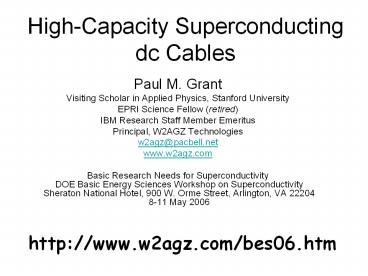High-Capacity Superconducting dc Cables - PowerPoint PPT Presentation
1 / 17
Title:
High-Capacity Superconducting dc Cables
Description:
High-Capacity Superconducting dc Cables Paul M. Grant Visiting Scholar in Applied Physics, Stanford University EPRI Science Fellow (retired) IBM Research Staff Member ... – PowerPoint PPT presentation
Number of Views:114
Avg rating:3.0/5.0
Title: High-Capacity Superconducting dc Cables
1
High-Capacity Superconducting dc Cables
- Paul M. Grant
- Visiting Scholar in Applied Physics, Stanford
University - EPRI Science Fellow (retired)
- IBM Research Staff Member Emeritus
- Principal, W2AGZ Technologies
- w2agz_at_pacbell.net
- www.w2agz.com
- Basic Research Needs for Superconductivity DOE
Basic Energy Sciences Workshop on
Superconductivity Sheraton National Hotel, 900
W. Orme Street, Arlington, VA 22204 8-11 May
2006
http//www.w2agz.com/bes06.htm
2
Submitted 24 June 1966
Rationale Huge growth in generation and
consumption in the 1950s cost of transportation
of coal necessity to locate coal and nuke plants
far from load centers.
Furthermore, the utilities have recently become
aware of the advantages of power pooling. By
tying together formerly independent power systems
they can save in reserve capacity (particularly
if the systems are in different regions of the
country), because peak loads, for example, occur
at different times of day, or in different
seasons. To take advantage of these possible
economies, facilities must exist for the
transmission of very large blocks of electrical
energy over long distances at reasonable cost.
3
Specs
- LHe cooled
- Nb3Sn (TC 18 K)
- JC 200 kA/cm2
- H 10 T
- Capacity 100 GW
- /- 100 kV dc
- 500 kA
- Length 1000 km
4
- Refrigeration Spacing 20 km
- G-L Separator Distance 50 m
- Booster Pump Intervals 500 m
- Vacuum Pump Spacing 500 m
- Cost 800 M (8/kW) (1967)
4.7 B Today!
5
LASL SPTL (1972-79)
- Specifications
- 5 GW (/- 50 kV, 50 kA)
- PECO Study (100 km, 10 GW)
6
Garwin-Matisoo Bottom Line
This is not an engineering study but rather a
preliminary exploration of feasibility. Provided
satisfactory superconducting cable of the nature
described can be developed, the use of
superconducting lines for power transmission
appears feasible.
Whether it is necessary or desirable is another
matter entirely!
7
2004 Natural Gas End Use
Schoenung, Hassenzahl and Grant, 1997 (5 GW on
HTSC _at_ LN2, 1000 km)
Why not generate this electricity at the gas
field wellhead instead?
8
e-Pipe
9
e-Pipe Specs (EPRI, 1997)
Capacity 5 GW (/- 50 kV,50 kA)
Length 1610 km
Temperature Specs - 1 K/10 km _at_ 65 K - 1 W/m heat input - 21.6 kliters LN2/hr - 100 kW coolers - 120 gal/min
Vacuum - 10-5 10-4 torr - 10 stations - 10 km spaced - 200 kW each
10
e-Pipe/Gas/HVDC Cost Comparison
US cents/kWh
HTSC (5/kA-m _at_ 65 K) beats HVDC and Gas!
Miles
11
The Mackenzie Valley Pipeline
http//www.mackenziegasproject.com
1220 km 18 GW-thermal 2006 - 2009
12
MVP Specs
Pipeline Length 1220 km (760 mi)
Diameter 30 in (76 cm)
Gas Pressure 177 atm (2600 psia)
Pressurization Stations 250 km apart
Flow Velocity 5.3 m/s (12 mph)
Mass Flow 345 kg/s
Volume Flow 1.6 Bcf/d (525 m3/s)
Power Flow 18 GW (HHV Thermal)
Construction Schedule 2006 - 2010
Employment 25,000
Partners Esso, APG, C-P, Shell, Exxon
Cost 7.5 B (all private)
13
LNG SuperCable
Design for eventual conversion to high pressure
cold or liquid H2
14
MVP Wellhead Electricity
Electricity Conversion Assumptions
Wellhead Power Capacity 18 GW (HHV)
Fraction Making Electricity 33
Thermal Power Consumed 6 GW (HHV)
Left to Transmit as LNG 12 GW (HHV)
CCGT Efficiency 60
Electricity Output 3.6 GW (/- 18 kV, 100 kA)
15
Its 2030
- The Gas runs out!
- Build HTCGR Nukes on the well sites in the
Mackenzie Delta (some of the generator
infrastructure already in place) - Use existing LNG SuperCable infrastructure to
transport protons and electrons
16
Appearing in SCIENTIFICAMERICAN July, 2006
17
Gubsers Charge
- Visionary
- Yes!
- Futuristic
- Yes!
- Considers Total System or Functionality
- Studies Underway and Its Looking Good
- Basic Research May Be in Materials other than
Superconductors - No! (Wellmaybe cryo-Ge bipolars)
- Cant Be Done or Not Practical
- It Can Be Done!
- Practicality Depends Not on Technology, but
Rather on Societal and Economic Motivation! - Depends on Material or Engineering Breakthrough
- No! (But RTSC with R 0 Would Be Nice!)































